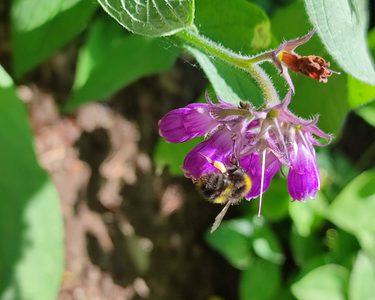Choosy flowers – why tongues matter!

In Britain, the majority of flowers are pollinated by insects – but it’s good to remember that insects and flowers have different motives. The insect ‘uses’ the flowers as a source of food, feeding on the nectar, a sugary-water solution that fuels flight. Some also feed on the pollen grains or take them back to their nest to feed their grubs.
The flowers have evolved to make use of insects to carry pollen between flowers. Therefore, they often need to restrict access to insects and ration amounts of pollen and nectar to ensure the insects do this job without taking liberties and helping themselves to too much food!
Some ‘primitive’ flowers such as buttercups or magnolias have a shallow dish shape and readily accessible pollen and nectar. A wide range of insects can land on these plants without having to hover. However, this wide accessibility does run the risk that pollen and nectar might be wasted.
Particular plants
Some plants are a bit choosier and have evolved a much deeper, tubular flower structure that’s only accessible by certain insects. This includes plants such as comfrey, bluebells, foxgloves and red clover.
We might just assume that all bumblebees are very similar, but they do in fact have very different lengths of tongues: the garden bumblebee (Bombus hortorum) has a tongue that’s a whopping 12mm so is able to easily feed on these plants while hovering. Many other bumblebees such as the buff tailed bumblebee (Bombus terrestris) have a tongue only half that length, so it’s more effort for them to feed on these. These bees do look quite similar, both with a white backside, so you might want to look at one of the excellent guides from the bumblebee conservation trust to hone in on the more detailed pattern of stripes.
A garden of all shapes and sizes
To make sure short-tongued insects such as the buff tailed bumblebees, honeybees and hoverflies aren’t left out, incorporate a range of flowers with a shallower structure in your garden. This includes all of the carrot family such as fennel and dill, Asteraceae family such as Echinacea or Cosmos, salvias and many others.
And you might think, why don’t all insects just develop long tongues so they can feed on anything? In fact, the advantage comes when they go to a shallow flower, because they can quickly drink on the nectar without having to unfurl a large unwieldy long tongue. And then there are, of course, the short-tongued bees that like to bite at the bottoms of the flowers to rob the nectar. There’s always a way to break the system!